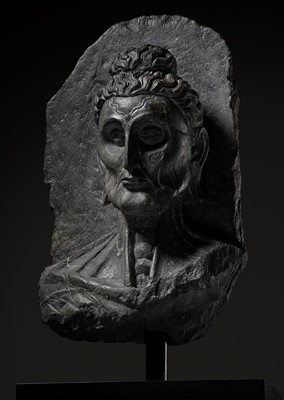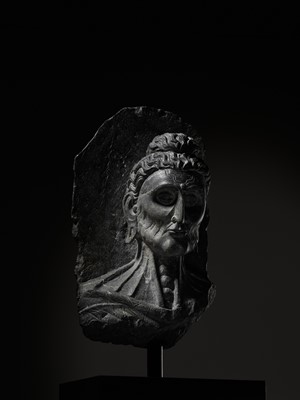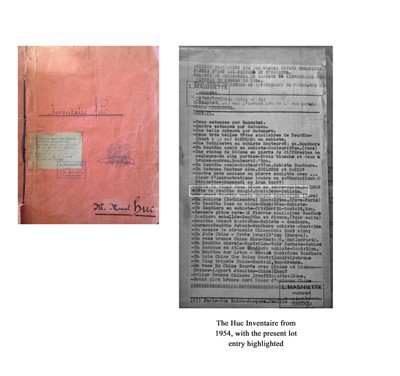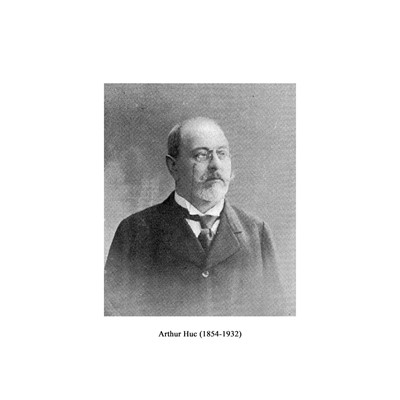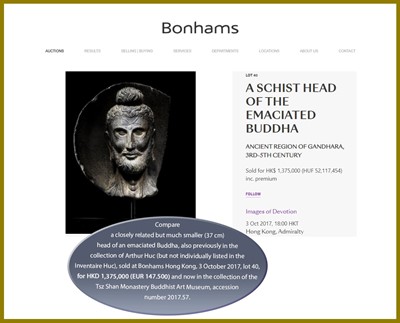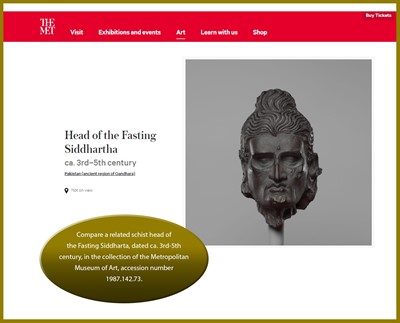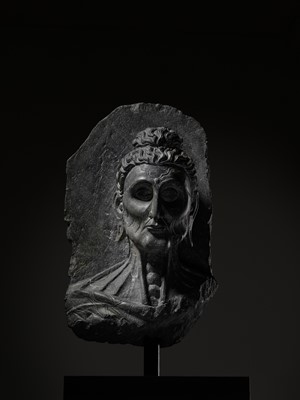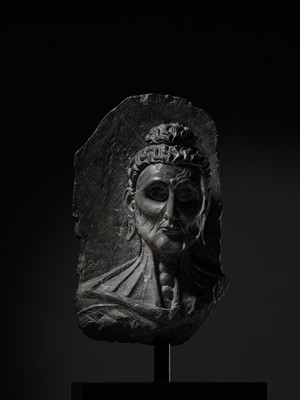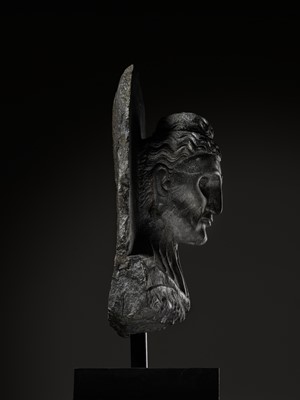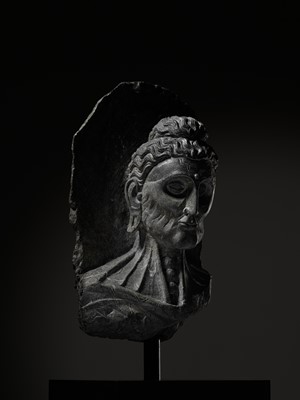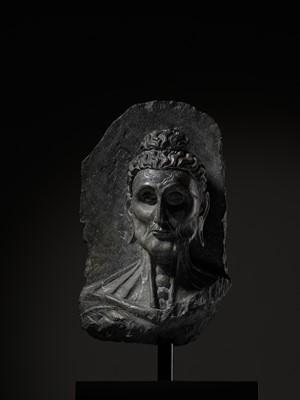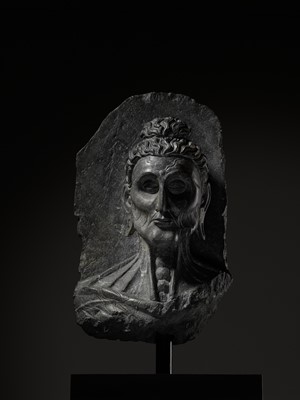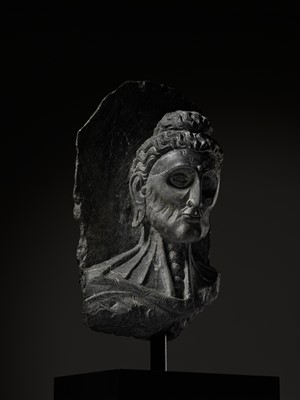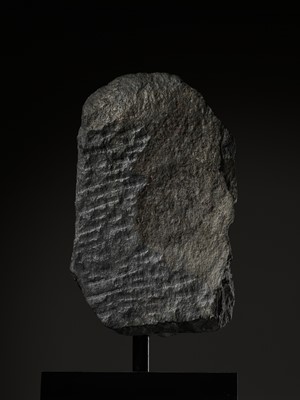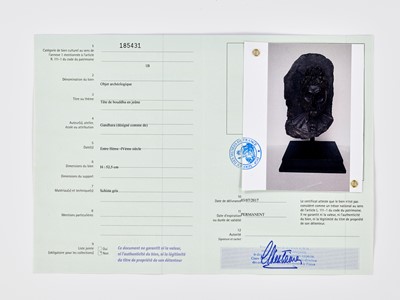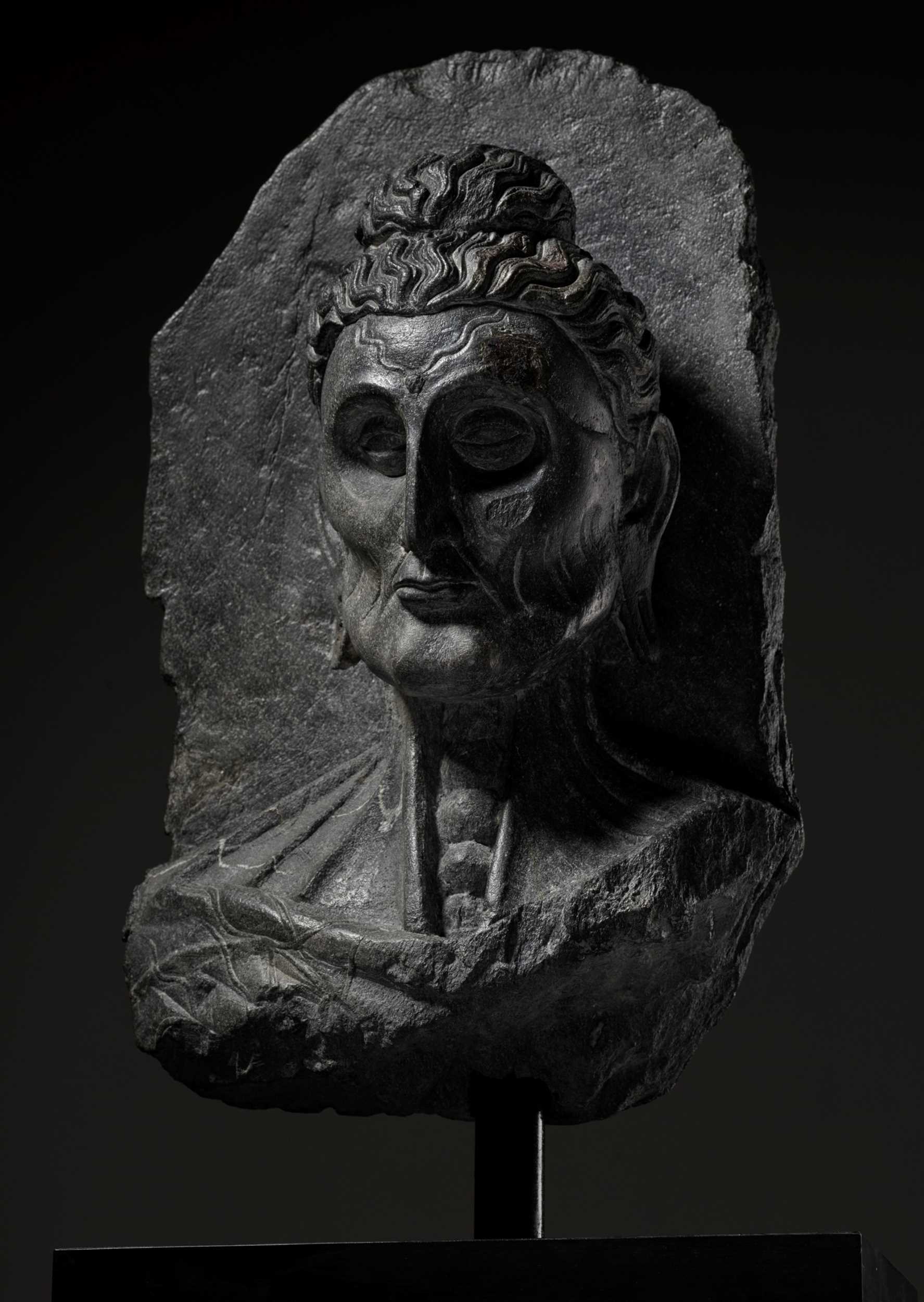16th Oct, 2021 10:00
TWO-DAY AUCTION - Fine Chinese Art / 中國藝術集珍 / Buddhism & Hinduism
542
A SCHIST HEAD OF THE EMACIATED BUDDHA, GANDHARA
健陀羅片岩佛陀苦行頭像
Sold for €69,520
including Buyer's Premium
Ancient region of Kushan, 3rd century. Depicted at the brink of starvation, sustained asceticism has withered Buddha’s body down to its bare anatomy under paper-thin skin. It clings to the cartilage of his trachea, the brittle muscles of his neck, the veins crisscrossing his forehead. Meanwhile, he glares out beyond the cavernous eye-sockets transfixed with a persistent and emboldened insight. The present sculpture bears the telltale signs of raised edges rubbed smooth where beholders were gripped with the overt temptation to caress the cheekbones or forehead.
Provenance: Arthur Huc (1854-1932). Marcel Huc, inherited from the above. Thence by descent within the same family. Arthur Huc was the chief editor of La Dépêche du Midi, at the time the leading newspaper in Toulouse, France. He was also an accomplished art critic and early patron of several artists, including Henri de Toulouse- Lautrec. At the same time, Arthur Huc was a keen collector of Asian art, a passion that he inherited from his legendary ancestor Évariste Régis Huc, also known as the Abbé Huc (1813-1860), a French Catholic priest and traveler who became famous for his accounts of Qing-era China, Mongolia and especially the then-almost-unknown Tibet in his book “Remembrances of a Journey in Tartary, Tibet, and China”.
Condition: Excellent condition, commensurate with age. Extensive wear, weathering, structural cracks and signs of deep erosion. Naturally grown, even, dark patina. Two areas of loss (one to hair and one to proper left eyebrow), both with minor remnants of old fill. Soil encrustations, mostly to back. Remnants of old varnish.
Inventory List: In 1954, L. Magniette, bailiff of the court in Toulouse (Huissier), was ordered to compile a complete inventory of the collection inherited by Marcel Huc from his father, Arthur Huc, the so-called “Inventaire Huc”. The present lot is listed in this inventory as follows: “Tête de Bouddha émacié. Haut 54 cm. Schiste.” (Head of an emaciated Buddha. Height 54 cm. Schist.) A copy of the inventory list and cover page are accompanying this lot.
French Export License: Certificat d’exportation pour un bien culturel Nr. 185431 dated 3 July 2017 has been granted and is accompanying this lot.
Weight: 38.7 kg
Dimensions: Height 54 cm (excl. stand) and 68 cm (incl. stand)
With an associated modern stand. (2)
Compared to the abundance of Siddharthas, Teaching Buddhas, and Maitreyas, only three Gandharan sculptures of Emaciated Buddha are known from excavation records, making them not only one of the most evocative, but also rarest images from the ancient region of Gandhara, and the Buddhist world at-large. Famous examples are held in the Lahore Museum, the Peshawar Museum, and The Metropolitan Museum of Art (see Khan, Gandhara: The Buddhist Civilization from Pakistan, Beijing, 2009, pages 224-225, and Ingholt, Gandharan Art in Pakistan, New York, 1957, no. 53, and Behrendt, The Art of Gandhara, New Haven, 2007, pages 56-57, nos. 45 & 46, respectively).
Scholars believe the subject refers to one of two pivotal moments in Buddha's life. Some, that it depicts the six years Siddhartha spent accomplishing the extreme asceticism promulgated by Brahmanic sages of his time, before renouncing its folly and proclaiming Buddhism's middle path to enlightenment between the extremes of austerities and sensual indulgence. Others, that it portrays Buddha rapt within seven weeks of sustained meditation immediately following his enlightenment, fasting all the while (Behrendt, The Art of Gandhara, New Haven, 2007, pages 57-58).
As Behrendt points out, these rare depictions of Buddha were 'first among the ascetics [and would have appealed] to a lay community that respected religious figures who had full control of ascetic disciplines, [as] part of an effort to bring these groups into the Buddhist fold' (ibidem).
Literature comparison: Compare a related schist head of the Fasting Siddharta, dated ca. 3rd-5th century, in the collection of the Metropolitan Museum of Art, accession number 1987.142.73.
Auction result comparison: Compare a closely related but much smaller (37 cm) head of an emaciated Buddha, also previously in the collection of Arthur Huc (but not individually listed in the Inventaire Huc), sold at Bonhams Hong Kong, 3 October 2017, lot 40, for HKD 1,375,000 (EUR 147,500) and now in the collection of the Tsz Shan Monastery Buddhist Art Museum, accession number 2017.57.
健陀羅片岩佛陀苦行頭像
貴霜王朝,三世紀。瘦骨嶙峋的苦行佛陀頭像,面部顴骨高聳,眼眶凹陷,額頭血管清晰可見,脖頸處肌肉脈絡顯露無遺。其目光卻毫不飄忽,堅定而專注。
來源:Arthur Huc (1854-1932)收藏。 Marcel Huc繼承,自此保存在同一家族至今。 Arthur Huc是La Dépêchedu Midi的主編,這是當時法國圖盧茲的主要報紙。他還是一位出色的藝術評論家,也是包括Henri de Toulouse- Lautrec在內的幾位藝術家的早期贊助人。同時,Arthur Huc是一位熱衷於亞洲藝術的收藏家,他的熱情源於他的傳奇祖先Évariste Régis Huc,中文名為古察伯(1813-1860),是法國天主教神父和旅行作家,在他的《韃靼西藏旅行記》書中描述了他在清朝的遊歷以及對蒙古尤其是當時幾乎鮮為人知的西藏的敘述。
品相:狀況極佳,與年齡相稱。 大面積磨損、風化、結構裂縫和深度侵蝕。 自然的深色包漿。頭髮和左邊眉毛區域缺失,有少量的舊時填充物。土壤結殼,多出現在背面。舊漆的殘留物。
收藏清單:1954年,圖盧茲法院法警 L. Magniette奉命對Marcel Huc從其父親Arthur Huc繼承的收藏品進行完整目錄彙編,即所謂的“Inventaire Huc”。此拍品也在當時列出的收藏清單中“ Tête de Bouddha émacié. Haut 54 厘米. Schiste.” (佛頭,高54厘米,片岩)。 隨附清單和封面副本。
法國出口證書:隨附文化產品出口證書 Nr. 185431,簽發於2017年7月3日。
重量:38.7 公斤
尺寸:高 54 厘米 (不含底座) ,總68 厘米
現代支架 (2)
與常見的悉達多、傳道釋迦牟尼和彌勒佛像相比,文獻記錄中現在僅存三尊犍陀羅苦行佛造像。苦行佛不僅是犍陀羅地區最令人回味的形象之一,也是最稀有的形象之一。 著名的例子在拉合爾博物館、白沙瓦博物館和大都會博物館。 (見 Khan, Gandhara: The Buddhist Civilization from Pakistan, 北京, 2009, 頁224-225, 以及Ingholt, Gandharan Art in Pakistan, New York, 1957, no. 53, 與 Behrendt, The Art of Gandhara, New Haven, 2007, 頁 56-57, nos. 45 & 46,).
學者們認為這個主題是指佛陀一生中兩個關鍵時刻之一。 它描繪了悉達多花了六年時間完成了他那個時代的婆羅門聖人所宣揚的極端苦行主義,宣布佛教在苦行和感官放縱的極端之間的啟蒙之路。 其次,它也描繪了佛陀在成道後立即進行禁食來持續冥想的七週內全神貫注 (Behrendt, The Art of Gandhara, New Haven, 2007, 頁 57-58)。
正如 Behrendt 指出的那樣,這些罕見的佛陀描繪是“苦行者中的第一個完全尊重苦行紀律的宗教人物,並以此努力度化衆生。”
文獻比較:比較一件片岩苦行悉達多,約三至五世紀,紐約大都會博物館,藏品編號 1987.142.73。
拍賣結果比較:比較一件相近但稍小 (37 厘米) 的苦行佛頭,同樣來自Arthur Huc 收藏 (但沒有在其收藏編錄上), 見香港邦翰思2017年10月3日lot 40, 售價 HKD 1,375,000 (EUR 147.500) ,現存於慈山寺佛教藝術博物館,編號2017.57。
Ancient region of Kushan, 3rd century. Depicted at the brink of starvation, sustained asceticism has withered Buddha’s body down to its bare anatomy under paper-thin skin. It clings to the cartilage of his trachea, the brittle muscles of his neck, the veins crisscrossing his forehead. Meanwhile, he glares out beyond the cavernous eye-sockets transfixed with a persistent and emboldened insight. The present sculpture bears the telltale signs of raised edges rubbed smooth where beholders were gripped with the overt temptation to caress the cheekbones or forehead.
Provenance: Arthur Huc (1854-1932). Marcel Huc, inherited from the above. Thence by descent within the same family. Arthur Huc was the chief editor of La Dépêche du Midi, at the time the leading newspaper in Toulouse, France. He was also an accomplished art critic and early patron of several artists, including Henri de Toulouse- Lautrec. At the same time, Arthur Huc was a keen collector of Asian art, a passion that he inherited from his legendary ancestor Évariste Régis Huc, also known as the Abbé Huc (1813-1860), a French Catholic priest and traveler who became famous for his accounts of Qing-era China, Mongolia and especially the then-almost-unknown Tibet in his book “Remembrances of a Journey in Tartary, Tibet, and China”.
Condition: Excellent condition, commensurate with age. Extensive wear, weathering, structural cracks and signs of deep erosion. Naturally grown, even, dark patina. Two areas of loss (one to hair and one to proper left eyebrow), both with minor remnants of old fill. Soil encrustations, mostly to back. Remnants of old varnish.
Inventory List: In 1954, L. Magniette, bailiff of the court in Toulouse (Huissier), was ordered to compile a complete inventory of the collection inherited by Marcel Huc from his father, Arthur Huc, the so-called “Inventaire Huc”. The present lot is listed in this inventory as follows: “Tête de Bouddha émacié. Haut 54 cm. Schiste.” (Head of an emaciated Buddha. Height 54 cm. Schist.) A copy of the inventory list and cover page are accompanying this lot.
French Export License: Certificat d’exportation pour un bien culturel Nr. 185431 dated 3 July 2017 has been granted and is accompanying this lot.
Weight: 38.7 kg
Dimensions: Height 54 cm (excl. stand) and 68 cm (incl. stand)
With an associated modern stand. (2)
Compared to the abundance of Siddharthas, Teaching Buddhas, and Maitreyas, only three Gandharan sculptures of Emaciated Buddha are known from excavation records, making them not only one of the most evocative, but also rarest images from the ancient region of Gandhara, and the Buddhist world at-large. Famous examples are held in the Lahore Museum, the Peshawar Museum, and The Metropolitan Museum of Art (see Khan, Gandhara: The Buddhist Civilization from Pakistan, Beijing, 2009, pages 224-225, and Ingholt, Gandharan Art in Pakistan, New York, 1957, no. 53, and Behrendt, The Art of Gandhara, New Haven, 2007, pages 56-57, nos. 45 & 46, respectively).
Scholars believe the subject refers to one of two pivotal moments in Buddha's life. Some, that it depicts the six years Siddhartha spent accomplishing the extreme asceticism promulgated by Brahmanic sages of his time, before renouncing its folly and proclaiming Buddhism's middle path to enlightenment between the extremes of austerities and sensual indulgence. Others, that it portrays Buddha rapt within seven weeks of sustained meditation immediately following his enlightenment, fasting all the while (Behrendt, The Art of Gandhara, New Haven, 2007, pages 57-58).
As Behrendt points out, these rare depictions of Buddha were 'first among the ascetics [and would have appealed] to a lay community that respected religious figures who had full control of ascetic disciplines, [as] part of an effort to bring these groups into the Buddhist fold' (ibidem).
Literature comparison: Compare a related schist head of the Fasting Siddharta, dated ca. 3rd-5th century, in the collection of the Metropolitan Museum of Art, accession number 1987.142.73.
Auction result comparison: Compare a closely related but much smaller (37 cm) head of an emaciated Buddha, also previously in the collection of Arthur Huc (but not individually listed in the Inventaire Huc), sold at Bonhams Hong Kong, 3 October 2017, lot 40, for HKD 1,375,000 (EUR 147,500) and now in the collection of the Tsz Shan Monastery Buddhist Art Museum, accession number 2017.57.
健陀羅片岩佛陀苦行頭像
貴霜王朝,三世紀。瘦骨嶙峋的苦行佛陀頭像,面部顴骨高聳,眼眶凹陷,額頭血管清晰可見,脖頸處肌肉脈絡顯露無遺。其目光卻毫不飄忽,堅定而專注。
來源:Arthur Huc (1854-1932)收藏。 Marcel Huc繼承,自此保存在同一家族至今。 Arthur Huc是La Dépêchedu Midi的主編,這是當時法國圖盧茲的主要報紙。他還是一位出色的藝術評論家,也是包括Henri de Toulouse- Lautrec在內的幾位藝術家的早期贊助人。同時,Arthur Huc是一位熱衷於亞洲藝術的收藏家,他的熱情源於他的傳奇祖先Évariste Régis Huc,中文名為古察伯(1813-1860),是法國天主教神父和旅行作家,在他的《韃靼西藏旅行記》書中描述了他在清朝的遊歷以及對蒙古尤其是當時幾乎鮮為人知的西藏的敘述。
品相:狀況極佳,與年齡相稱。 大面積磨損、風化、結構裂縫和深度侵蝕。 自然的深色包漿。頭髮和左邊眉毛區域缺失,有少量的舊時填充物。土壤結殼,多出現在背面。舊漆的殘留物。
收藏清單:1954年,圖盧茲法院法警 L. Magniette奉命對Marcel Huc從其父親Arthur Huc繼承的收藏品進行完整目錄彙編,即所謂的“Inventaire Huc”。此拍品也在當時列出的收藏清單中“ Tête de Bouddha émacié. Haut 54 厘米. Schiste.” (佛頭,高54厘米,片岩)。 隨附清單和封面副本。
法國出口證書:隨附文化產品出口證書 Nr. 185431,簽發於2017年7月3日。
重量:38.7 公斤
尺寸:高 54 厘米 (不含底座) ,總68 厘米
現代支架 (2)
與常見的悉達多、傳道釋迦牟尼和彌勒佛像相比,文獻記錄中現在僅存三尊犍陀羅苦行佛造像。苦行佛不僅是犍陀羅地區最令人回味的形象之一,也是最稀有的形象之一。 著名的例子在拉合爾博物館、白沙瓦博物館和大都會博物館。 (見 Khan, Gandhara: The Buddhist Civilization from Pakistan, 北京, 2009, 頁224-225, 以及Ingholt, Gandharan Art in Pakistan, New York, 1957, no. 53, 與 Behrendt, The Art of Gandhara, New Haven, 2007, 頁 56-57, nos. 45 & 46,).
學者們認為這個主題是指佛陀一生中兩個關鍵時刻之一。 它描繪了悉達多花了六年時間完成了他那個時代的婆羅門聖人所宣揚的極端苦行主義,宣布佛教在苦行和感官放縱的極端之間的啟蒙之路。 其次,它也描繪了佛陀在成道後立即進行禁食來持續冥想的七週內全神貫注 (Behrendt, The Art of Gandhara, New Haven, 2007, 頁 57-58)。
正如 Behrendt 指出的那樣,這些罕見的佛陀描繪是“苦行者中的第一個完全尊重苦行紀律的宗教人物,並以此努力度化衆生。”
文獻比較:比較一件片岩苦行悉達多,約三至五世紀,紐約大都會博物館,藏品編號 1987.142.73。
拍賣結果比較:比較一件相近但稍小 (37 厘米) 的苦行佛頭,同樣來自Arthur Huc 收藏 (但沒有在其收藏編錄上), 見香港邦翰思2017年10月3日lot 40, 售價 HKD 1,375,000 (EUR 147.500) ,現存於慈山寺佛教藝術博物館,編號2017.57。
Zacke Live Online Bidding
Our online bidding platform makes it easier than ever to bid in our auctions! When you bid through our website, you can take advantage of our premium buyer's terms without incurring any additional online bidding surcharges.
To bid live online, you'll need to create an online account. Once your account is created and your identity is verified, you can register to bid in an auction up to 12 hours before the auction begins.
Intended Spend and Bid Limits
When you register to bid in an online auction, you will need to share your intended maximum spending budget for the auction. We will then review your intended spend and set a bid limit for you. Once you have pre-registered for a live online auction, you can see your intended spend and bid limit by going to 'Account Settings' and clicking on 'Live Bidding Registrations'.
Your bid limit will be the maximum amount you can bid during the auction. Your bid limit is for the hammer price and is not affected by the buyer’s premium and VAT. For example, if you have a bid limit of €1,000 and place two winning bids for €300 and €200, then you will only be able to bid €500 for the rest of the auction. If you try to place a bid that is higher than €500, you will not be able to do so.
Online Absentee and Telephone Bids
You can now leave absentee and telephone bids on our website!
Absentee Bidding
Once you've created an account and your identity is verified, you can leave your absentee bid directly on the lot page. We will contact you when your bids have been confirmed.
Telephone Bidding
Once you've created an account and your identity is verified, you can leave telephone bids online. We will contact you when your bids have been confirmed.
Classic Absentee and Telephone Bidding Form
You can still submit absentee and telephone bids by email or fax if you prefer. Simply fill out the Absentee Bidding/Telephone bidding form and return it to us by email at office@zacke.at or by fax at +43 (1) 532 04 52 20. You can download the PDF from our Upcoming Auctions page.
How-To Guides
How to Create Your Personal Zacke Account
How to Register to Bid on Zacke Live
How to Leave Absentee Bids Online
How to Leave Telephone Bids Online
中文版本的操作指南
创建新账号
注册Zacke Live在线直播竞拍(免平台费)
缺席投标和电话投标
Third-Party Bidding
We partner with best-in-class third-party partners to make it easy for you to bid online in the channel of your choice. Please note that if you bid with one of our third-party online partners, then there will be a live bidding surcharge on top of your final purchase price. You can find all of our fees here. Here's a full list of our third-party partners:
- 51 Bid Live
- EpaiLive
- ArtFoxLive
- Invaluable
- LiveAuctioneers
- the-saleroom
- lot-tissimo
- Drouot
Please note that we place different auctions on different platforms. For example, in general, we only place Chinese art auctions on 51 Bid Live.
Bidding in Person
You must register to bid in person and will be assigned a paddle at the auction. Please contact us at office@zacke.at or +43 (1) 532 04 52 for the latest local health and safety guidelines.
